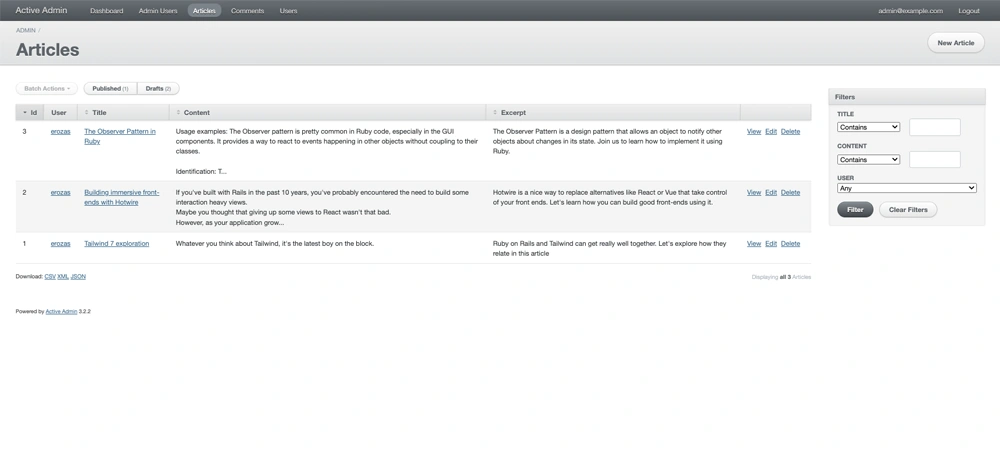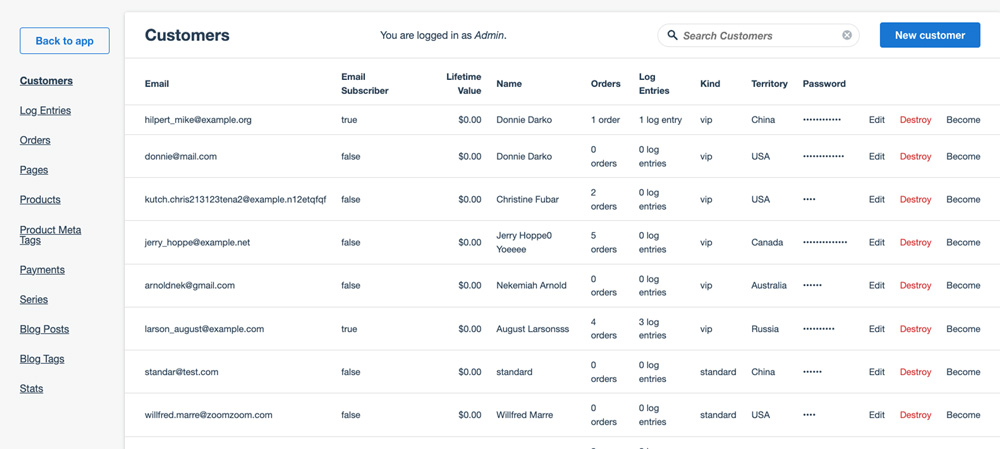Active Admin vs Administrate: which one is better?
Active Admin and Administrate were created with the same goal in mind: to help developers build admin panels and internal tooling faster.
However, Administrate was developed to address pain points that Active Admin had at the time—and arguably still has.
This is why they have different philosophies when it comes to design and implementation.
Let's see what makes them unique, their pros and cons so you can make an informed decision:
Active Admin: an overview

Even if Active Admin was not the first admin library for Rails (Active Scaffold, came before them) they have become one of the most, if not the most popular choice for Rails developers.
Out of the box, it comes with a lot of features that make creating admin panels from existing resources pretty easy, especially when starting out.
Here are the main aspects that distinguish Active Admin:
- Build CRUD interfaces from your resources: Active Admin allows you to generate CRUD interfaces with minimal intervention using the resources your application has. This reduces the amount of time it takes to build a functional admin panel/internal tool.
- DSL centric configuration: most configuration is located in resource files located under the app/admin directory. For example, if you have a Listing model you would add a listings.rb file and handle the admin configuration for your Listing resource there. There's also an 'ActiveAdmin' initializer where you can set global configuration in case you find yourself repeating configurations frequently.
- View component DSL via Arbre: Active Admin allows you to define view through a custom DSL library called Arbre. Even though the learning curve for Arbre isn't steep, newcomers or less experienced Ruby developers may find it confusing at first. However, once you get to know it, customizing Active Admin will be easier.
- Essential fields for starting out: Active Admin provides common fields needed to build admin panels through a wrapper around Formtastic. Out of the box you'll get fields like: text input, text area, number input, password input, date & datetime picker, checkboxes, select dropdown, multiselect, file upload field. Some commonly used fields like WYSIWYG editors or custom select tags are available through third party code.
- Sensible defaults and a somewhate complete feature set: one advantage of Active Admin is that, even if you're unfamiliar with its DSL or configuration, you can start building right away. Its feature set covers everything you need to start out, and community-developed plugins allow you to extend its functionality—even if some of them are not actively maintained.
Active Admin pros and cons
Being around for almost a decade, Active Admin has a lot of features that make it a good choice to build admin experiences using Rails.
This doesn't mean it's perfect or that it doesn't have any cons.
Let's explore the pros first:
-
Maturity: Active Admin has a lot of first party and community supported features. They still receive maintenance and, because of the amount of projects that depend on it, they will probably be around for the long run. Finding help or third party code to fit your needs will be easier than with newer alternatives.
-
A powerful DSL: almost everything you do with AA revolves around its DSL. Once you learn how it works and incorporate it into your daily workflow you can become very productive with Active Admin. AA also offers a view DSL called 'Arbre' which is used to define custom views the Active Admin way.
-
Great productivity gains when starting out: once you get familiar with Active Admin's DSL, you can build your admin panel very quickly, almost to the point where you will feel like you have superpowers. However, do not expect everything to be ideal forever; at some point your velocity may stagnate.
Now let's see some of the cons for Active Admin:
-
Customization is difficult: one of the weak links for Active Admin is that customization's not an easy task. Its DSL can be powerful and daunting when trying to customize it. Also, you might need to take a dive into their codebase to understand how some things are done to customize your admin panel.
-
Modest improvements: the library is not definitely not abandoned. However, with many years in the market and competing products arising, Active Admin just doesn't receive the amount of feature development and fixes it used to.
-
Dependent on outdated third-party plugins: Even if you can use Active Admin as is, the feature set is going to be pretty limited. Considering this, and the fact that the library is almost 15 years old, a considerable number of the third party libraries will be abandoned or unmaintained.
-
A mediocre UI: admin UIs are often neglected and Active Admin is no exception. Its UI is not polished and it's also not mobile friendly. A new version with UI improvements it's currently in beta.
-
Less than ideal official documentation: Official documentation exists in the official documentation page, their GitHub's Wiki and also scattered around the net.
Administrate: an overview

Administrate is an admin panel framework for Ruby on Rails built by the folks at Thoughtbot.
It was released in 2015 to tackle the issues that the main alternatives — Rails Admin and Active Admin — presented back then.
The most common problem was the difficulty to customize admins and the inevitable feeling that using a framework for the task would inevitably end in a DSL mess.
That's why Administrate came with a fresh approach that many people liked:
- Build admin panels using customizable scaffolding: Administrate helps you build admin panels and internal tooling by generating code you'd typically write in any Rails application. It also came with some goodies on top of scaffolding but it never stray too much from standard Rails code.
- Granular configuration with familiar code: if you want to customize the way an endpoint behaves there's no need to immerse yourself in a dense DSL. You can just generate the controller, call super to inherit Administrate's behavior and add the code you need to customize what happens in the action.
- Customize fields, views and dashboards using Rails view code: with Administrate you don't need to learn yet another DSL to customize your views and experience. You just generate custom fields, attribute partials, dashboards or entire pages.
- A moderate feature set: Administrate comes with a moderate feature set: it comes with a search form and basic filtering capabilities. It doesn't do much heavy lifting for you which is a pro and a con: you get to write your own features but that adds friction at the beginning.
- Minimal, Unopinionated UI: Administrates UI is nothing to write home about but it's minimal and, at least on desktop it's perfectly fine for most admin panels, at least when starting out.
Administrate pros and cons
Administrate can be a good choice to build Rails admin panels because of it's lightweight nature but it also comes with some disadvantages.
Let's see its pros first:
-
Ligthweight but powerful: Administrate doesn't try to be more than it should be. You get customizable scaffolds and ways to customize code during the request lifecycle. The library is also not that big so getting familiar with it is not a titanical task.
-
Easily customizable: this is probably the main selling point for Administrate. You can generate partials for a lot of the components that make up the library and customize them to your liking using familiar code.
-
Clean configuration: because of the way its designed, configuring and customizing Administrate doesn't pollutes your application code. If you decide you don't want to use Administrate anymore and maybe replace it with your own scaffolds, your application code will be mostly untouched. You cannot say the same about alternatives like Rails Admin or Administrate
-
A decent ecosystem: even though it doesn't rival the third party plugins other frameworks have. There are a decent amount of plugins written for Administrate.
Now let's see some of the cons:
-
Not actively developed: Administrate is still in pre-1.0 (as of version 0.20.1). Updates are sparse, and it’s unclear if it will be actively maintained in the future. After 9 years of its release that may be a red flag for some developers.
-
By default it feels like a database viewer: the lack of a great feature set can be seen as a disadvantage by some people. By default, it generates very basic CRUD views and some work—and perhaps third party code—is needed to achieve desired functionality.
-
Outdated front-end: Administrate still dependes on jQuery and doesn't use the current Rails way which includes goodies like Stimulus, Hotwire, Turbo and utility-first CSS libraries like Tailwind.
-
Poor documentation: Administrate's documentation consists of 12 pages of content. That is not enough to cover the basic use cases, even for a library that's as simple as Administrate.
So which one should I pick? Active Admin or Administrate?
The decision to pick one over the other is pretty subjective because it depends on your needs and preferences.
Both libraries are differente in approaches and design so, to summarize it you should pick Active Admin if:
- You need a mature and strong framework: Active Admin has ben arround for 14 years and it has a lot of features out of the box and a lot of features added by third-party plugins that can enrich your experience.
- You are comfortable with DSLs: Active Admin is designed around a DSL that's used for practically everything. If you strongly dislike DSLs or have had bad experiences with them in the past, Active Admin is probably not for you.
- You are pretty sure about the future state of your application: this means that either it's a personal project, you're a stakeholder or you are very certain that your admin panel needs won't be growing way outside of the scope of what Active Admin is good at.
- You want an MVP done as soon as possible: if you don't care too much about the future of your admin panel or you don't even know if your product will be around in 6 months, you can leverage Active Admin.
Conversely, you should pick Administrate over Active Admin if:
- You don't care about putting a little work to reach your needs: with Administrate you will probably need to put some work to reach functionality that most admin panels need, even when starting out. Functional search, filtering, batch actions, file uploads, advanced fields are among the things you will need to figure out when using Administrate.
- You are comfortable working with a stale library: even though it still receives some updates and the 1.0 version is currently in beta, considering past history the library is not guaranteed to be maintained in the long run.
- Your admin panel needs are basic: if you don't need fancy features or can handle your admin panel being simple at first, Administrate is a good choice because it's lightweight and easy to customize.
Having said this, we want you to present a third alternative that picks where Administrate and Active Admin left and redefines what an admin panel framework should be:
Meet Avo: an alternative to Active Admin or Administrate
If you're looking for an Active Admin Alternative or an Administrate Alternative, you should consider Avo.
Avo is a young and actively maintained library that aims to build on where its predecessors left off.
It has a lot of features, a great community and users that push Avo's development forward every day.
Let's explore how Avo can make your life easier as a Rails developer:
Avo: an overview

Avo is an admin panel framework that's set to improve the existing admin experiences for Ruby on Rails applications.
We respect the work our predecessors did to lay the foundation for Rails admin frameworks and we aim to improve what they did by providing a modern, flexible, easy to use solution with Avo.
We believe that Avo is an improvement over both Avo alternatives.
Yes, we know we are biased: after all we spend a lot of time building this product but we really think that Avo can make your life better while developing Rails applications.
Lets take a look at Avo's features and pros:
Avo's features and pros
Avo has been around since 2020 and it has a lot of features that can make your life easier as a Rails developer.
Here are some of them:
-
A vast variety of fields: Avo comes packed with most of the fields you're going to need in your application without the need to write any code or use third party plugins: text, WYSIWYG textareas with Trix or Tip Tap, password, number, boolean, datetime, taglist, enum, file, image, sound, video, etc. Also, if you get to the point where Avo's fields are not enough, you can easily create your own custom fields.
-
Most common admin features out of the box: It doesn't matter if this is your first or n-th admin panel. Avo can help you build solutions way faster than other alternatives by providing you with the right features at the right time. Plus, our release cycle is tight so we're constantly improving the experience we provide and adding features taking customer feedback into consideration.
-
Excellent documentation: Avo's documentation is one of our top priorites. We put a lot of effort into documenting the library, especially considering that we have a very tight release cycle. With our documentation you will find everything you need quickly and without the need to go through third party resources.
-
Customization is easy: we know that customizing your admin panel is one of the main pain points that developers experience when using admin frameworks. That's why we've built Avo with customization as a first class citizen. We provide a lot of what we like to call "escape hatches" so you can customize your admin panel and not feel like you're fighting against it.
-
Delightful UI: with Avo you don't need to a dime on design to have a sharp and clean looking admin panel for your applications.
-
Active development: we are constantly working on Avo taking customer feedback into consideration and improving our product every day to make it better for you and other Rails developers.
-
Current Rails best practices: Avo uses Hotwire and Stimulus to bring a highly interactive experience to the table without the need to write boatloads of front-end code.
-
Configuration doesn't pollute your application: even though Avo's configured through a DSL like Active Admin, it doesn't pollute your application code like other alternatives do.
Avo being a paid product
We know that Avo being a paid product might make you reconsider or even deter you from even trying it.
However, you should know that Avo has a very generous free tier that you can use to build your next awesome application without the need to pay for it.
Also Avo being a paid product means that we can dedicate our time to making it a better product every day so you can focus on your application instead of worrying if we will be around for the next version or if your feature requests are going to be considered at all.
But even if you don't pay for Avo you can still enjoy it because around 70% of our features are present in the community tier.
Feel free to Try Avo and see for yourself how it can help you build faster and better using Rails.



